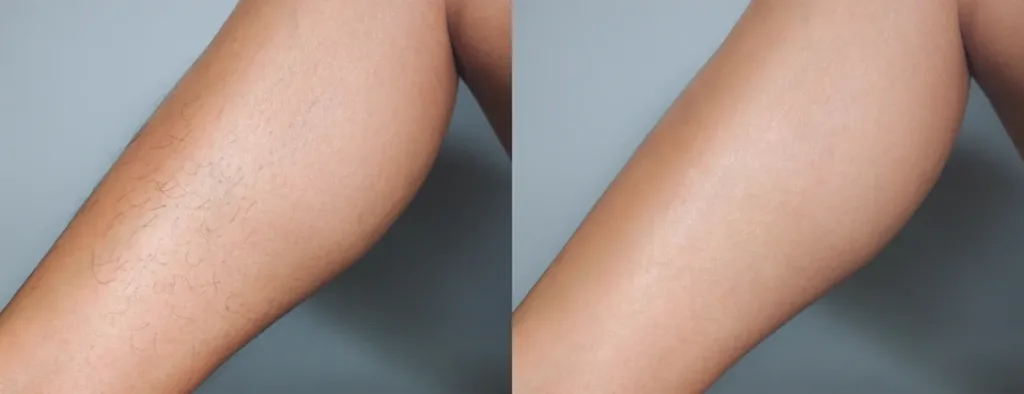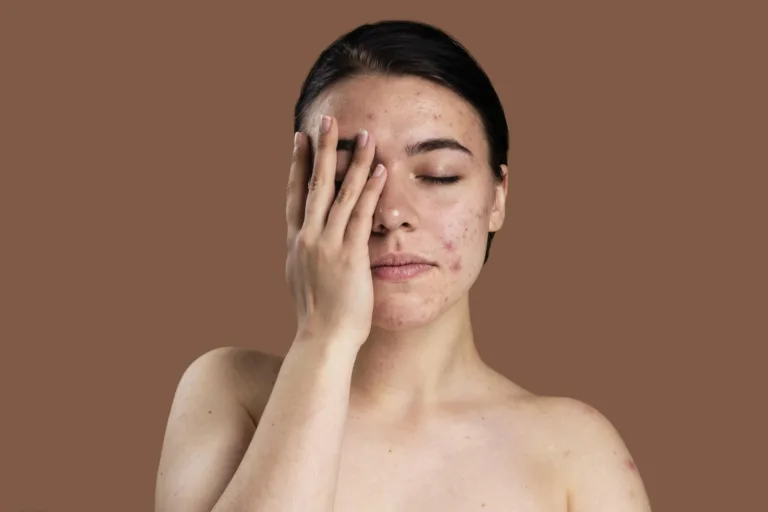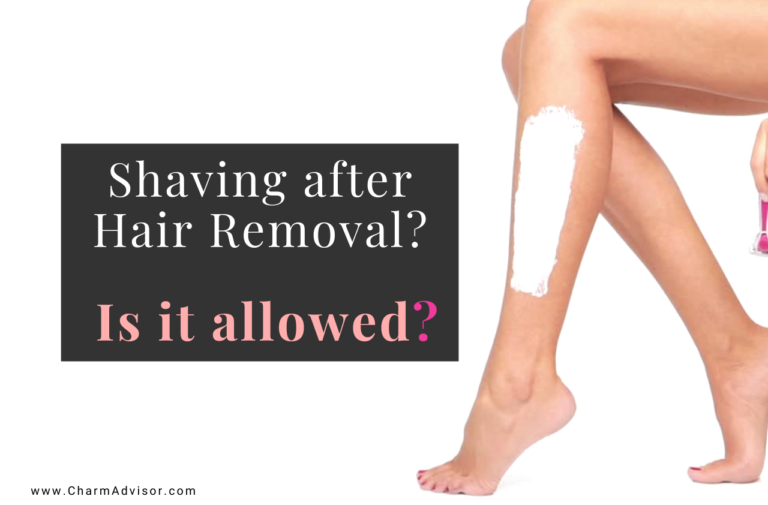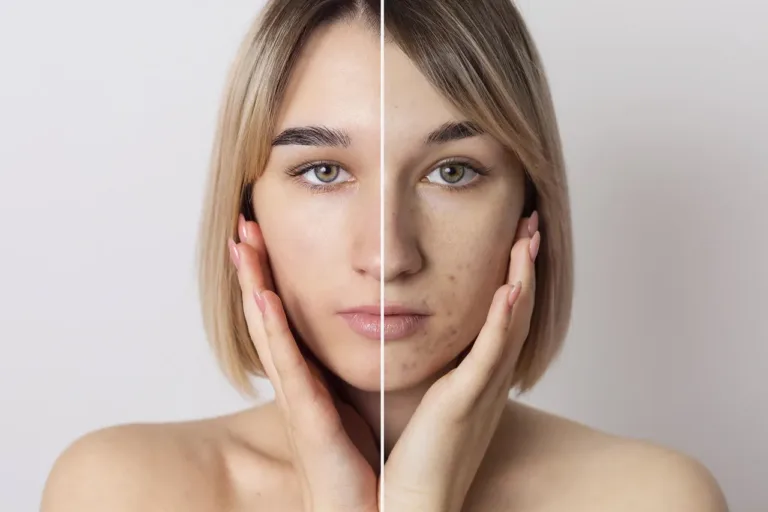
Overview
Laser hair removal (Laser HR) is a popular cosmetic procedure in which concentrated light beams are used to remove unwanted hair from various areas of the body. The procedure is designed to selectively target the hair follicles while leaving the surrounding skin undamaged. With several benefits including precision, speed, and predictability, laser hair removal has become a preferred option for those looking for a more permanent solution to hair removal.
This article provides an in-depth overview of laser hair removal, including its benefits, preparation, procedure, recovery, risks, and costs. We’ll also take a closer look at how the procedure works and what to expect during the treatment. If you’re considering Laser HR, this article will provide you with all the information you need to make an informed decision.
Table of Contents
How Laser Hair Removal Works
Laser hair removal is a popular method for getting rid of unwanted hair, and it’s particularly effective. If you’re considering laser hair removal, it’s important to understand how the process works.
Laser HR works by targeting the pigment in the hair follicle with a beam of light. The light energy is absorbed by the pigment, which then converts to heat and destroys the hair follicle. This process is called selective photothermolysis.
It works best on those with dark, coarse hair. The laser is attracted to the pigment in the hair, so the darker and coarser the hair, the more effective the treatment will be. The laser is not effective on blonde, gray, or white hair, as these colors lack sufficient pigment to attract the laser.
The treatment is performed with a handheld laser device, which emits a burst of light energy onto the skin. The device is moved over the treatment area, and the laser pulses for a fraction of a second to target the hair follicles. Most people describe the sensation as a mild snapping or stinging feeling, but it’s generally well-tolerated.
Why do you need Laser hair removal? Why it’s done?

Laser hair removal is a cosmetic procedure that is done to permanently reduce or remove unwanted hair on the body. The procedure uses highly concentrated light to target hair follicles and destroy them, preventing hair growth. There are various reasons why people opt for laser hair removal:
1. Convenience: Laser hair removal is a convenient way to remove hair from large areas of the body, such as the legs, back, and chest. It saves time and effort compared to traditional hair removal methods like waxing, shaving, or threading.
2. Confidence: Unwanted hair growth can often lead to a lack of confidence. Laser hair removal can help improve self-esteem by removing hair from areas that are causing discomfort or embarrassment.
3. Medical reasons: Some medical conditions like hirsutism (excessive hair growth) or ingrown hairs can be managed with laser hair removal. It can also be helpful for people with sensitive skin who experience irritation and razor burn from other hair removal methods.
4. Aesthetics: Laser hair removal can be a popular option for people who prefer the aesthetic of smooth, hair-free skin. It’s common for athletes, models, and actors who need to maintain a certain appearance to opt for this procedure.
Overall, laser hair removal is done for both cosmetic and medical reasons. It provides a long-term solution to unwanted hair growth, reduces the need for constant maintenance, and can improve self-confidence.
Benefits of Laser Hair Removal

Laser hair removal is a popular cosmetic procedure that offers several benefits. Here are some of the key benefits of laser hair removal:
1. Precision: Lasers can selectively target dark, coarse hairs while leaving the surrounding skin undamaged. This makes it an ideal option for removing hair from sensitive areas like the face, underarms, and bikini line.
2. Speed: Laser hair removal is a relatively fast procedure. Each pulse of the laser takes only a fraction of a second and can treat many hairs at the same time. The laser can treat an area approximately the size of a quarter every second. Small areas such as the upper lip can be treated in less than a minute, and large areas, such as the back or legs, may take up to an hour.
3. Predictability: Most patients experience permanent hair loss after an average of three to seven sessions. This means that you can expect long-lasting results with laser hair removal.
4. Convenience: Unlike shaving or waxing, which require regular maintenance, laser hair removal offers a more permanent solution. You won’t have to worry about ingrown hairs, razor burn, or the hassle of constantly removing unwanted hair.
5. Improved Skin Quality: Shaving and waxing can cause skin irritation, ingrown hairs, and other skin problems. Laser hair removal, on the other hand, can improve the overall quality of your skin by reducing hair growth and minimizing skin irritation.
Overall, laser hair removal is an effective and convenient way to remove unwanted hair from almost any part of the body. Whether you’re looking to eliminate hair from your face, legs, arms, or bikini line, laser hair removal can help you achieve smooth, hair-free skin.
Preparing for Laser Hair Removal (How to prepare for laser hair removal)

Before undergoing laser hair removal, there are several steps that you should take to ensure the best results and reduce the risk of complications. These include:
1. Research and consultation: It is essential to do thorough research and choose a qualified and experienced professional for laser hair removal. Check their credentials, reviews, and make sure they use FDA-approved equipment.
2. Limit hair removal methods: Avoid plucking, waxing, or electrolysis for at least two weeks before the treatment. These methods remove the hair root, which is the target of the laser. Shaving, however, is allowed and recommended before the procedure.
3. Avoid sun exposure: Avoid sun exposure for at least two weeks before and after the treatment. Sun exposure makes laser hair removal less effective and increases the risk of complications such as skin discoloration.
4. Skin preparation: The skin should be thoroughly cleaned and free of any lotions, deodorants, or makeup before the procedure. Depending on the sensitivity of the skin, the technician may apply a topical anesthetic cream 30 minutes before the procedure.
5. Hair trimming: The hair in the treatment area should be trimmed to a few millimeters above the skin surface to ensure better results.
6. Medical history: It is crucial to inform the technician of any medical conditions or medications you are taking that may affect the treatment.
By following these guidelines, you can ensure optimal results and reduce the risk of complications during and after laser hair removal.
What to Expect During Laser Hair Removal

Laser hair removal is a medical procedure that should be performed by a trained professional. It is important to know what to expect during the procedure to ensure that it is done safely and effectively.
1. Consultation: Before the procedure, you will have a consultation with the technician or doctor who will be performing the laser hair removal. During the consultation, they will assess your skin and hair type to determine the most effective laser and settings to use. They will also discuss any potential risks or side effects, as well as the number of treatments you may need.
2. Preparing the Skin: On the day of the procedure, the area to be treated will be cleansed, and the hair will be trimmed to a few millimeters above the skin surface. A topical numbing cream may be applied to the area 20-30 minutes before the procedure to reduce any discomfort.
3. Protecting the Skin: Both you and the technician will need to wear protective eyewear during the procedure. The technician will also apply a cold gel or use a special cooling device to protect the outer layers of your skin and help the laser penetrate the skin.
4. Laser Treatment: During the procedure, the technician will use a handheld laser device to deliver pulses of light to the treatment area. You may feel a mild stinging sensation during the procedure, but the numbing cream should help to reduce any discomfort.
5. Post-Treatment Care: After the procedure, the technician may apply ice packs or a cooling cream to ease any discomfort. You should avoid sun exposure and use a high SPF sunscreen for several weeks after the procedure. You may also be advised to avoid hot showers, saunas, and strenuous exercise for a few days after the treatment.
6. Follow-Up Treatments: You will need multiple laser hair removal treatments to achieve the desired results. The number of treatments needed depends on the area being treated, the thickness of the hair, and your skin type. Typically, treatments are spaced 4-6 weeks apart.
It is important to follow the technician’s aftercare instructions carefully to ensure the best results and reduce the risk of complications.
What to Expect After the procedure
After the laser hair removal procedure, it is common to experience redness and swelling in the treated area, which may feel like a mild sunburn. It is important to avoid exposing the treated area to direct sunlight or tanning beds for at least two weeks after the procedure, as this can increase the risk of complications.
It is also recommended to avoid using any harsh chemicals, such as perfumes or scrubs, on the treated area for several days after the procedure. If necessary, aloe vera gel or a mild moisturizer can be applied to soothe the skin.
In some cases, the treated hair may fall out immediately after the procedure, while in others it may take a few days or weeks for the hair to shed. It is important to avoid picking or pulling at the treated hair, as this can lead to scarring or skin damage.
In the weeks following the procedure, it is common to experience some hair regrowth in the treated area. This is because laser hair removal only targets hair follicles that are actively producing hair, and not all hair follicles are in this active growth phase at the same time. Additional laser hair removal treatments may be necessary to target these newly active hair follicles.
Overall, it is important to follow the aftercare instructions provided by the laser hair removal technician or doctor to ensure the best possible results and to minimize the risk of complications.
Recovery and Risks
After laser hair removal, the treated area of the skin may look and feel like it’s sunburned for a day or two. This is normal and can be managed with cool compresses and moisturizers. If the face is treated, makeup can be applied the next day, unless the skin is blistering.
Over the next month, the treated hair will fall out. It is recommended to wear sunscreen for the following month to prevent temporary changes in the color of the treated skin.
Blisters are rare, but they are more likely to occur in people with darker complexions. Other potential side effects include swelling, redness, and scarring. Permanent scarring or changes in skin color are rare, but they can occur.
It is crucial to follow the post-treatment care instructions provided by the technician or doctor. Avoiding sun exposure, using sunscreen, and avoiding harsh chemicals or scrubs in the treated area are important to minimize the risk of complications.
In some cases, the treated hair may regrow, especially if it was not targeted effectively during the procedure. In such cases, additional sessions may be required to achieve the desired results.
Overall, laser hair removal is a safe and effective procedure with a low risk of complications when performed by a qualified technician or doctor. However, it is essential to discuss any concerns or potential risks with the provider before the procedure.
Results
Laser hair removal is a highly effective and long-lasting solution for reducing unwanted hair growth. While it may not provide permanent hair removal, many people experience a significant reduction in hair growth after a series of treatments. The results of laser hair removal vary from person to person and depend on several factors, such as skin and hair type, treatment area, and the number of sessions completed.
Typically, after the first treatment, patients will experience a reduction in hair growth, but it may take several sessions to achieve the desired results. Most people require between three to seven sessions to achieve permanent hair loss, and some may require more. The results of laser hair removal can last for several months to years, depending on the individual’s response to the treatment.
It is essential to note that laser hair removal may not be effective for everyone, and there is no guarantee that it will provide permanent hair reduction. Some people may experience hair regrowth after a few months or years, while others may experience partial hair regrowth in some areas. It is also essential to continue with maintenance treatments to maintain the results.
Overall, the results of laser hair removal can be highly beneficial, providing individuals with smoother, hair-free skin for extended periods. However, it is crucial to manage your expectations and understand that it may take several sessions to achieve the desired results. It is also important to consult with a qualified medical professional before undergoing treatment to determine if you are a suitable candidate and to discuss your expectations and goals.
What about home lasers?
While there are many laser hair removal devices available for home use, they are not as effective as professional treatments done in a clinic or spa. The main reason for this is that home devices have lower energy levels and smaller spot sizes, making them less powerful and precise than professional-grade lasers.
Home laser devices may also not be suitable for all skin and hair types, and can cause adverse side effects such as burns, scarring, or changes in skin pigmentation if used improperly. Additionally, home devices do not provide the same level of customization and monitoring that professional treatments do, which can result in inconsistent or unsatisfactory results.
It is important to note that the FDA regulates home laser devices differently than professional-grade lasers, and does not require the same level of safety testing and efficacy standards. As a result, it is recommended to use caution when considering a home laser device and to consult with a dermatologist or medical professional before use.
Overall, while home Laser HR devices may seem like a convenient and cost-effective option, they do not provide the same level of effectiveness and safety as professional treatments. It is recommended to seek out a trained professional for laser hair removal to ensure the best possible results and minimize the risk of adverse side effects.
Laser HR Alternatives?
While Laser HR is a popular option for long-lasting hair reduction, there are other alternatives that may be suitable for different skin and hair types or personal preferences. Here are some of the most common alternatives to laser hair removal:
1. Waxing:
Waxing involves applying a warm wax to the skin and then removing it with a strip of cloth or paper, which pulls out the hair from the roots. The results can last for several weeks, but the process can be painful and may cause skin irritation.
2. Sugaring:
Similar to waxing, sugaring involves applying a paste made of sugar, lemon juice, and water to the skin, then removing it with a strip of cloth. Sugaring is considered a gentler alternative to waxing, as the paste adheres only to the hair and not to the skin.
3. Depilatory creams:
These creams contain chemicals that break down the hair shaft, making it easy to wipe away with a cloth or sponge. They are a quick and painless alternative, but the results usually last only a few days.
4. Shaving:
Shaving involves using a razor or electric shaver to remove hair from the skin’s surface. It is a quick and easy option, but the results only last for a few days and can lead to ingrown hairs.
5. Electrolysis:
This method involves inserting a tiny needle into each hair follicle and applying an electrical current to destroy the hair root. It is a more permanent solution than laser hair removal, but it can be time-consuming and may cause skin irritation.
6. IPL (Intense Pulsed Light):
IPL uses broad-spectrum light to target the hair follicles, similar to laser hair removal. However, it is less precise and can cause more skin irritation. It may also not be effective for all skin and hair types.
Ultimately, the best hair removal method depends on individual preferences, skin and hair types, and the desired results. It’s always a good idea to consult with a dermatologist or licensed esthetician to determine the best course of action.
Costs of Laser Hair Removal
The cost of Laser HR can vary depending on several factors, including the size of the treatment area, the number of sessions needed, and the location of the treatment center. Generally, larger areas such as the back or legs will cost more than smaller areas like the upper lip or underarms.
The number of sessions required also plays a significant role in determining the total cost. Most people need between 4 and 8 sessions to achieve the desired results, but some may need more. The cost per session may also decrease if you purchase a package of multiple sessions.
The location of the treatment center can also affect the cost. Treatment centers in larger cities or affluent areas may charge more than those in smaller or less expensive locations.
On average, the cost of Laser HR in the United States ranges from $200 to $500 per session. This means that the total cost for a full treatment plan can range from $800 to $4,000 or more.
It’s important to note that laser hair removal is generally considered a cosmetic procedure and is not typically covered by health insurance. However, some providers may offer financing options or payment plans to make the procedure more affordable.
Overall, Laser HR can be a significant investment, but many people find that the benefits and long-term results make it worth the cost.
Types of Laser hair removal:
Laser hair removal is a cosmetic procedure that uses laser technology to remove unwanted hair from various parts of the body. There are several types of lasers used for hair removal, each with its own benefits and drawbacks. Here are the most common types of lasers used for hair removal:
1. Alexandrite Laser:
This type of laser is best suited for those with fair skin and dark hair. It has a larger spot size, which means it can cover a larger area of skin faster. It works by emitting a red light that is absorbed by the melanin in the hair follicle, which damages it and prevents future hair growth.
2. Diode Laser:
This type of laser is versatile and can be used on all skin types, but it is most effective on those with lighter skin and darker hair. It works by emitting a longer wavelength of light that can penetrate deeper into the skin, targeting the hair follicle while leaving the surrounding skin unharmed.
3. Nd:YAG Laser:
This type of laser is best suited for those with dark skin and dark hair. It works by emitting a longer wavelength of light that can bypass the melanin in the skin and target the melanin in the hair follicle. This reduces the risk of burns and other complications associated with laser hair removal on darker skin types.
4. IPL (Intense Pulsed Light):
While not technically a laser, IPL is often used for hair removal. It works by emitting a broad spectrum of light that targets the melanin in the hair follicle, damaging it and inhibiting future hair growth. IPL is generally less effective than lasers, but it can be a good option for those with lighter skin and hair.
5. Ruby Laser:
This type of laser is rarely used for hair removal anymore due to its limited effectiveness and potential to cause burns and scarring. It emits a shorter wavelength of light that is only effective on those with very light skin and dark hair.
It’s important to note that not all lasers are created equal, and the effectiveness of the treatment depends on several factors, including the type of laser used, the color and thickness of the hair, and the patient’s skin type. It’s important to consult with a licensed and experienced laser technician to determine which type of laser is best for you.
FAQs:
-
How many sessions are required for laser hair removal?

The number of sessions required for laser hair removal depends on the individual’s hair growth and the area being treated. Generally, most people need between 6 to 8 sessions for optimal results.
-
Is laser hair removal painful?
Laser hair removal can cause some discomfort, but it is generally well-tolerated by most people. Some people describe the sensation as similar to a rubber band snapping against the skin. However, most modern lasers come equipped with a cooling mechanism to minimize discomfort.
-
Is laser hair removal safe?
Yes, laser hair removal is considered safe when performed by a licensed and trained professional using FDA-approved equipment. However, there are some risks and side effects associated with the procedure, including skin irritation, discoloration, and burns.
-
Can laser hair removal be done on any part of the body?
Laser hair removal can be performed on almost any part of the body, including the face, legs, arms, underarms, back, chest, and bikini area.
-
Can laser hair removal be done on all skin types?
Laser hair removal can be performed on most skin types, but certain types of laser devices may be better suited to certain skin tones. People with darker skin tones may require a specific type of laser that targets the hair follicle without damaging the surrounding skin or causing hyperpigmentation.
-
How long does each session of laser hair removal take?
The length of each laser hair removal session depends on the size of the area being treated. Smaller areas such as the upper lip or underarms can take as little as 15-20 minutes, while larger areas such as the back or legs may take up to an hour.
-
What should I avoid before and after laser hair removal?
Before laser hair removal, you should avoid waxing or plucking the hair in the treatment area for at least 4-6 weeks. After the procedure, it is recommended to avoid sun exposure and tanning for at least two weeks, as well as any activities that may cause sweating or friction in the treatment area.
-
Is laser hair removal permanent?
While laser hair removal can significantly reduce hair growth, it is not considered a permanent solution. Over time, some hair may regrow, but it will be finer and lighter in color. Maintenance sessions may be needed to maintain the results.
-
Can I shave in between laser hair removal sessions?
Yes, you can shave in between laser hair removal sessions. However, it is important to avoid other hair removal methods such as waxing, plucking, or electrolysis, which can interfere with the laser treatment.
-
How long does laser hair removal last?
Laser hair removal can last anywhere from several months to several years, depending on the individual’s hair growth patterns and skin type. Most people require multiple sessions to achieve long-lasting results.
-
Can laser hair removal cause hair to grow back thicker or darker?
No, laser hair removal does not cause hair to grow back thicker or darker. In fact, many people experience a reduction in hair growth after each treatment.
-
Is laser hair removal safe during pregnancy?
Laser hair removal targets dark pigment in the hair and causes thermal and/or mechanical damage to the hair follicle. There are no studies that evaluate the safety of laser hair removal during pregnancy. Many health care providers recommend avoiding laser hair removal during pregnancy because of the lack of information about the effect on the fetus.







